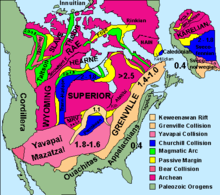Churchill Craton

The Churchill Craton is the northwest section of the
Major tectonometamorphic intervals
- 2.69 Ga: deformation in the northern Hearne Domain.
- 2.685 Ga: greenschist-grade metamorphism and deformation in the central Hearne Domain.
- 2.60 Ga: granitoid plutonismacross the northern Hearne and Rae Domains.
- 2.50-2.55 Ga: metamorphism and deformation in the northern Hearne domain.
- 1.9 Ga: metamorphism and deformation in the northern Hearne Domain.
- 1.83 Ga: magmatism and deformation in the northern Hearne and Rae Domains.
- 1.755 Ga: plutonism in the western Hearne and eastern Rae Domains.
Hearne Domain, Western Churchill province
A north-northwest-trending crustal segment transects from Kaminak Lake (central Hearne Domain) in the south to Yathkyed Lake (northern Hearne Domain) in the northwest, consisting of Archean supracrustal belts that preserve mostly Archean mafic to felsic volcanic rocks (greenschist-grade supracrustal and granitoids), metamorphic cooling of hornblende and Proterozoic biotite.
This section of the Churchill province was formerly called the Ennadai-Rankin
Murmac Bay Group, Western Churchill province
The Murmac Bay Group exposed in the southwestern half of the Western Churchill Craton, near
Taltson Magmatic Zone and Taltson basement
The
Economic geology
There is aggressive diamond exploration drilling in the south Slave Province, NWT, Churchill Craton (at the northwest corner of the
Unlike the Slave Craton, which is covered with shallow lakes and swamp, the eastern part of the Churchill Craton is drier. Kimberlites may be obscured by foliage rather than water, therefore many targets may be drillable during the summer, not just during the short winter window when lakes are frozen and daylight is available. In comparison, drilling in the Eastern Arctic is too remote compared to the Slave Craton, which is serviced by the fully developed infrastructure of Yellowknife. The Eastern Arctic is serviced by the smaller town of Rankin Inlet, which in turn is serviced by barge during summer.
See also
References
Notes
- ^ Sandeman 2001, pp. 3–4
- ^ Sandeman 2001, pp. 4–5
Sources
- Sandeman, H. A. (2001). "40Ar-39Ar Geochronological Investigations of the Central Hearne Domain, Western Churchill Province, Nunavut: A Progress Report" (PDF). Geological Survey of Canada, Current Research. 2001-F4. Retrieved 28 May 2016.
